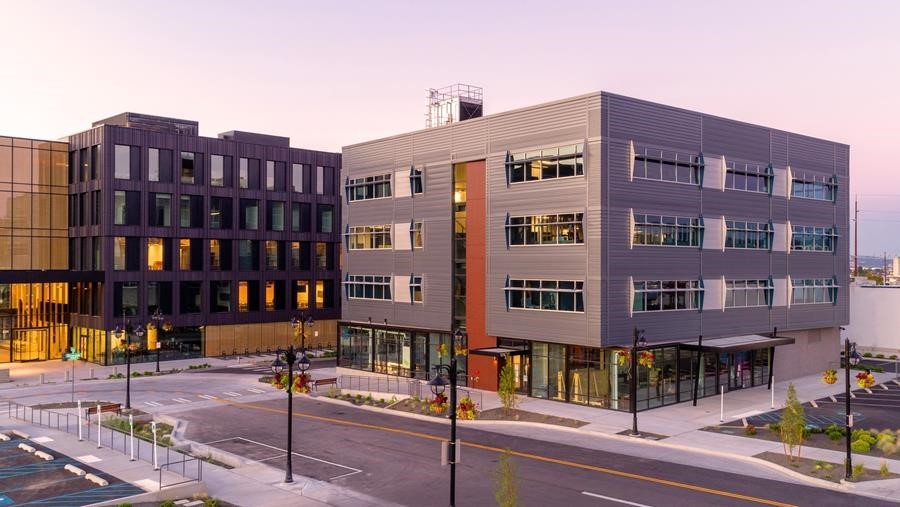Scott Morris Center for Energy Innovation
Friday, September 18, 2020

NOTE: for a recap of the virtual grand opening, see this link http://www.catalystspokane.com/
See this link for some nice drone footage courtesy of Eastern Washington University.
(Photo credit: courtesy Chris Thompson/Eastern Washington University)
(as reported in The Spokesman-Review by Nicholas Deshais, photo courtesy McKinstry; also see https://www.ewu.edu/catalyst/ and this drone footage)
Development at the south landing of Spokane’s University District Gateway Bridge on East Sprague Avenue continues with the announcement Tuesday of a partner building to Avista’s Catalyst project.
The four-story Hub facility (recently renamed The Scott Morris Center for Energy Innovation) will be 40,000 square feet and include a restaurant and office space. The building also will house a central energy plant to power it as well as the neighboring Catalyst building.
Construction of the $50 million Catalyst building, which will house three degree programs and about 1,000 Eastern Washington University students, has begun, and both it and the Hub are expected to be complete in early 2020.
Development of the site, which is joined to the University District by the pedestrian bridge, is a joint project between Avista and McKinstry, a Seattle-based company that specializes in energy-efficient buildings.
When complete, the buildings will be part of a “shared energy district,” said Michael Frank, vice president of engineering at McKinstry, with the Hub providing most of the electricity.
“It will provide heating, cooling and power to multiple buildings on the campus,” Frank said, noting only two buildings are planned now but more could be added later. “A traditional building doesn’t really care what happens on the other side of the power meter. We’re making sure it’s a good user of the grid, a good team player of the grid.”
The Catalyst building will be “net zero,” meaning it will produce as much energy as it uses.
“That means that at times over the year it will produce, the summer especially, more power than it needs,” Frank said. “That extra power goes back into the grid.”
The Catalyst building will be designed to use far less energy than a traditional building. The Catalyst will be built with cross-laminated timbers, a steel-like wood product developed by California-based Katerra and produced at the company’s factory in Spokane Valley.
The Hub, Frank said, will be built in more traditional ways.
Gabe Boeckman, a spokesman for McKinstry, said the building had no tenants yet, including the restaurant. He noted a space in the Catalyst building proposed for a coffee shop also doesn’t yet have a tenant.
Avista began buying property on the block that has become the south landing in 2016. In all, it has acquired 1.5 acres on the block for nearly $4.4 million.
In June, the Spokane City Council committed $430,000 for street improvements, water service and other infrastructure to serve the Catalyst building, the largest economic incentive ever offered by the city. After months of delays, the pedestrian bridge opened last month.
The larger goal of the Catalyst project is to build “the five smartest city blocks on the planet” that will “serve as a replicable model to encourage sustainable building design worldwide,” according to a statement from McKinstry.
Wordcount: 464
Published: Jan. 9, 2019, midnight